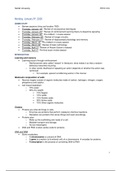Class notes
PSYC 318 Winter 2020 FULL NOTES
- Course
- Institution
3-hour class too long to sit through? Scared you'll be missing details for the final exam? Have no fear, these notes have your back! Presenting one of the most complete note packages that exist for PSYC 318! The author, an extremely experienced note-taker, has listened to the whole 8 lectures in de...
[Show more]



